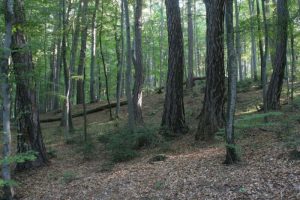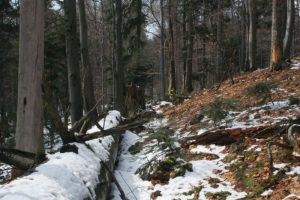Strict protection areas are designated in reserves and national parks. They cover terrains where a high degree of naturalness is preserved, and natural processes take place spontaneously, without direct human interference. Sometimes, strict protection is applied in degraded areas with a view to observing spontaneous succession and transformations that occur in ecosystems.
There are 5 strict protection areas, formerly called strict reserves, in the Świętokrzyski National Park. Together they cover 1,731.3 ha, which is about 23 % of the entire Park area

“Chełmowa Góra” (“Mount Chełmowa”) strict protection area
Established in 1920, “Chełmowa Góra” has always attracted great attention of researchers. It became one of the most famous reserves in Poland, owing its renown to M. Raciborski, Ph.D., who in 1890, after having examined cons and branches of larches from Chełmowa Góra, wrote the first thesis on the Polish larch, entitled “A few words about the larch in Poland”.
N. A. Troickij, a Russian scholar, was one of the first people to suggest the necessity to protect this area. He was conducting scientific research on Chełmowa Góra in the years 1911-1913. He called the area a living botanical museum, and demanded that this site be restricted from economic development. In 1913, W. Szafer, Ph.D., in his thesis “Contribution to the knowledge of Erasian larches with a particular emphasis on the larch in Poland”, described the features of the larch from Chełmowa Góra as a new species, and named it Polish Larch Laris polonica Rac.
When the Świętokrzyski National Park was established in 1950, this strict protection area was reduced to 13.36 ha. It comprises the northern-western parts of Chełmowa Góra massive. The remaining area is covered by partial protection in order to create optimal conditions for the Polish larch restoration (for self-seeding) as the intensive development of the lower forest storey, consisting of beech, sycamore, oak, and fir, had been preventing the photophilous larch from spontaneous renewal.
Chełmowa Góra is a small but distinctive hill (347m above sea level). This isolated forest complex is situated to the north-east of the main range of the Świętokrzyskie mountains, in the Pokrzywiański range at the mouth of the Słupianka river to the Pokrzywianka river.
According to the last inventory (2002), in “Chełmowa Góra” there are as many as 286 tree monuments: 171 larches, 93 beeches, 4 pines, 4 wild cherries, 2 hackberries, and 1 lime. Among rare plant species there are: ostrich fern, stiff clubmoss, great horsetail, goat’s beard, and many others. Particularly noteworthy is also an impressive number of ant-hills. About 500 of them have been found, which is very unusual in such a small area.

“Łysica” reserve was established in 1924. It stretches along the Łysogóry ridge, from Św. Katarzyna village, in the direction of Św. Krzyż mountain, to Hucka Pass, a deep depression of land nearby Szklana Huta village. It encompasses not only almost the entire massive of Łysica (613m above sea level), which is the highest peak of the Łysogóry range, but also northern and southern sides of the ridge, nearly to the half of the slope. The protection covers the everlasting forest, which has not been subject to human interference for the past 80 years. It is one of the oldest, after the Białowieża Forest, part of the woodland where natural processes occur spontaneously. The forest stand is multi-species, uneven-aged, and has a complex natural structure. It consists of fir and beech, with the addition of sycamore, Norway maple, and large-leaved lime.
Well preserved parts of primary nature are a mainstay of natural plant communities and animal populations. The mosaic of old, young, and dead trees is interrupted by boulder fields, called gołoborza, which are completely or partially overgrown with ferns and single trees. Here, you can also find beautiful quartzite outcrops, known as Skałka Agata, Księża Skała, and Widna Skała. Gołoborze (the boulder field) on the peak of Łysica is equally impressive.

“Święty Krzyż” reserve was established in 1924. The area encompasses southern and northern slopes of Łysa Góra, also known as Łysiec (595 m above sea level), the second highest peak in the Świętokrzyskie Mountains.
The protection in this area covers natural fir and fir-beech forests, which have a well-preserved complex structure, and undergo natural processes. Among the young generation of trees, there are huge old firs, called “mammoth firs”, and beech tree monuments. Numerous dead trees stand or lie, felled by the wind. Dead trunks bustle with life of countless organisms, for which they are a natural habitat, a place for shelter, winter sleep, and nesting.
On the slopes of Łysa Góra there are boulder fields, called gołoborza, a peculiarity of inanimate nature, clearly visible even from a distance. The vastest gołoborza can be admired from the viewing gallery located on the northern slope of Łysa Góra.

Established in 1954, “Czarny Las” covers the area of 26.45 ha. It is placed in the western part of the Dębniacka valley, which is an extension of the Wilkowka valley. The area includes the hill laying in the bifurcation of the Czarna Woda river and the Złoty Potok stream as well as the part of the Czarna Woda valley. “Czarny Las” is situated at the height of 285-303 metres above sea level.
The most widespread forest community is the oak-hornbeam forest Tilio-Carpinetum. As the share of this kind of forest complexes in the Park vegetation is very small, Tilio-Carpinetum is a truly valuable community from the scientific point of view.

“Mokry Bór” was established in 1954, and covers the area of 38.44 ha. It is placed at the foot of the mountain called Góra Psarska, in the water head area of the Czarna Woda river.
Marshy small-reed coniferous forests are under protection here. “Mokry Bór” is the only place in the Park with marshy coniferous forest communities. The forest stand consists of pine, with the addition of silver and downy birch, spruce, sessile oak, and fir.

